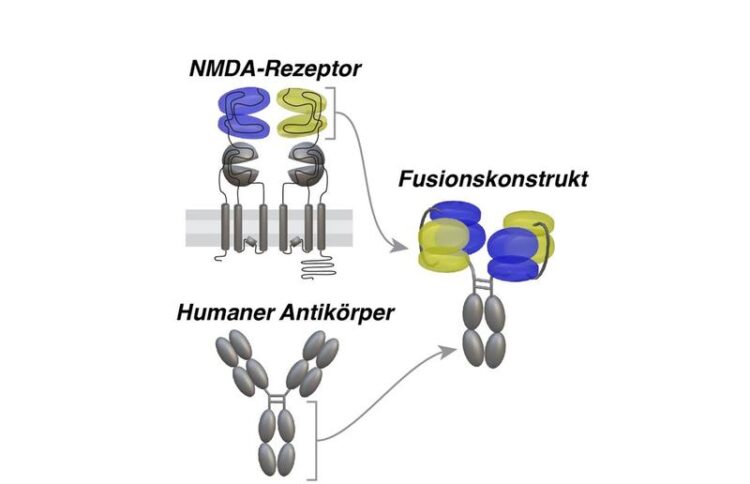Putting out the fire in the brain

Structure of the fusion construct that is used against autoimmune encephalitis. Domains of the NMDA receptor are stained in blue and yellow.
Image credits: Stefan Hallermann and Leipzig University
In autoimmune encephalitis, a rare but serious and sometimes life-threatening inflammation of the central nervous system, the body’s own defences are directed against the central nervous system.
This disease was first identified in 2007, and the most common type is Anti-NMDA receptor encephalitis. In this autoimmune disease, a protein that plays an important role in signal transmission in the brain is disrupted: the NMDA-type glutamate receptor, or NMDA receptor for short. Researchers from Braunschweig, Jena, Leipzig and Berlin have developed a new potential treatment for this disease.
In anti-NMDA receptor encephalitis, antibodies interfere with signal transmission in the brain. The receptors which the neurotransmitters glutamate and glycine bind to are internalised by the cells through antibody binding. This causes reduced signal transmission to neurons in the central nervous system. Those affected experience a wide variety of symptoms from epileptic seizures and psychoses such as hallucinations to loss of consciousness and coma. Patients describe the disease symptoms to be like a “fire in the brain” that they can’t control. The interdisciplinary DFG research unit SYNABS, consisting of researchers from several locations, is dedicated to the study of this disease.
“It is our goal to better understand the disease mechanisms and to develop new and target-specific therapeutic approaches using modern biotechnology,” said the group’s spokesperson, Professor Christian Geis from Jena University Hospital. With their translational research approach, the group has been able to discover a potential therapeutic agent. The molecule consists of a part of an NMDA receptor and a fragment of a human antibody. The pathogenic antibodies then bind to this fusion construct rather than to the NMDA receptors.
Eleonora Loi, PhD student at Jena University Hospital and member of the SYNABS consortium, explains, “We succeeded in proving the efficacy of this molecule in controlled behavioral studies with mice. Animals with experimental autoimmune encephalitis developed memory function similarly to healthy animals when they received the drug candidate. In diseased animals without therapy, memory formation was clearly impaired.” Additionally, the Jena project team investigated the physiological properties of the molecule in tissue.
In this project, the TU Braunschweig developed the fusion construct and analysed it biochemically. The partners at Jena University Hospital and the Faculty of Medicine at Leipzig University initiated the DFG research unit and have analysed neurons and conducted in vivo studies. The partners at Charité and Freie Universität in Berlin have identified the affected autoimmune antibodies in patients.
Wissenschaftliche Ansprechpartner:
Prof. Dr. Christian Geis
Neurology department, Universitätsklinikum Jena
christian.geis@med.uni-jena.de
Originalpublikation:
Stephan Steinke#, Toni Kirmann#, Eleonora A. Loi#, Jana Nerlich, Iron Weichard, Philip Kuhn, Torsten Bullmann, Andreas Ritzau-Jost, Filiz Sila Rizalar, Harald Prüss, Volker Haucke, Christian Geis*, Michael Hust* and Stefan Hallermann* (2023). NMDA-receptor-Fc-fusion constructs neutralize anti-NMDA receptor antibodies, Brain, 2023; awac497, https://doi.org/10.1093/brain/awac497
Weitere Informationen:
https://www.uniklinikum-jena.de/synabs/en/ SYNABS homepage
Media Contact
All latest news from the category: Life Sciences and Chemistry
Articles and reports from the Life Sciences and chemistry area deal with applied and basic research into modern biology, chemistry and human medicine.
Valuable information can be found on a range of life sciences fields including bacteriology, biochemistry, bionics, bioinformatics, biophysics, biotechnology, genetics, geobotany, human biology, marine biology, microbiology, molecular biology, cellular biology, zoology, bioinorganic chemistry, microchemistry and environmental chemistry.
Newest articles
Faster, more energy-efficient way to manufacture an industrially important chemical
Zirconium combined with silicon nitride enhances the conversion of propane — present in natural gas — needed to create in-demand plastic, polypropylene. Polypropylene is a common type of plastic found…

Energy planning in Ghana as a role model for the world
Improving the resilience of energy systems in the Global South. What criteria should we use to better plan for resilient energy systems? How do socio-economic, technical and climate change related…

Artificial blood vessels could improve heart bypass outcomes
Artificial blood vessels could improve heart bypass outcomes. 3D-printed blood vessels, which closely mimic the properties of human veins, could transform the treatment of cardiovascular diseases. Strong, flexible, gel-like tubes…




















